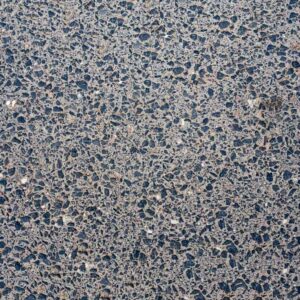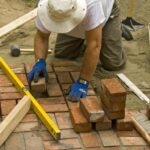What is exposed aggregate concrete and should you install it? This guide looks at how it’s installed, pros and cons, and the cost of exposed aggregate concrete.
Exposed aggregate concrete is concrete with a twist. Instead of having just the gray, smooth texture of a concrete slab, these surfaces have a pebble-like texture because an aggregate material like pebbles, stones, river rock—or even seashells or recycled glass—is mixed into the concrete and left exposed and visible on the surface.
Exposed aggregate concrete finishes give both indoor and outdoor surfaces a unique, contemporary look that combines the beauty of masonry with industrial style. This type of decorative concrete finish is a durable, stylish home improvement choice for stunning textured concrete driveways, patios, pool decks, and barbecue counters outdoors as well as concrete floors, countertops, and similar surfaces indoors.
Pros and cons of exposed aggregate concrete
An exposed aggregate surface has many benefits and a few drawbacks. Because it is somewhat pricey and virtually permanent, it’s important to consider these before having exposed aggregate decorative concrete installed.
Benefits. One of the biggest “pros” is that exposed aggregate has a particularly interesting and textured appearance that, depending upon the materials used, can range from naturally rugged to a clean, refined finish. In addition, the natural slip-resistant qualities make it a great choice for driveways, floors, pool decks, patios, and walkways where increased traction under foot is important. Lastly, it’s very durable and requires little maintenance—just occasional cleaning or pressure washing with a mild detergent to remove dirt and debris.
Drawbacks. On the flip side, there are a couple “cons”. Exposed concrete is typically more costly than standard concrete because of the added materials and labor involved in installation (see more about cost below). For some rougher textures—especially where tender bare feet are involved, like on pool decks—some coarse materials can be uncomfortable underfoot. Because the textured surface can trap moisture, exposed aggregate surfaces are particularly vulnerable to freeze-thaw damage in cold climates. Applying a high-quality concrete sealer can help protect against this problem.
Important considerations
Before you opt for an exposed aggregate concrete surface, be sure to:
- Choose the right aggregate for your project—one that complements your project’s design and color scheme. Once it’s mixed into the concrete, it’s permanent.
- Prepare the site properly before pouring concrete. The surface should be level and, for some types of projects—particularly those outdoors—proper drainage is essential so water doesn’t pool on the surface.
- Protect the surface from debris, foot traffic, or other damage during installation. After installation, it’s usually best to have the surface sealed with a high-quality concrete sealer to protect it from stains.
How exposed aggregate is installed
The aggregate material may be mixed with the concrete before the liquid concrete mix is poured into formwork, or applied as a top layer that’s worked into the surface after the concrete is poured. In the case of the latter “dry shake” method, the concrete is first poured and leveled, and then a dry mixture of cement, pigments, and fine aggregate is broadcasted as a top layer onto the still-soft surface. The aggregate is worked into the surface with masonry tools like floats and trowels. Then the surface is allowed to solidify, and the aggregate is exposed by removing surface cement with a high-pressure water jet or acid wash.
Once the concrete mix has cured, it can be given a finish that protects it from damage and stains. A high gloss “wet look” is sometimes used outdoors for maximum protection against stains and weathering. A gloss finish may be used indoors or out to create a nice, shiny, reflective look that enhances the aggregate’s color and texture. A satin or low-gloss finish provides a more natural look both indoors and outdoors. A matte finish is sometimes used indoors to create a very contemporary or industrial look—but this may not be suitable for high-traffic outdoor surfaces.
Cost of exposed aggregate concrete
The cost of installing exposed aggregate concrete can range from $6 to $18 per square foot or more depending upon several factors, including the project’s size and complexity and local costs. On the average, the cost can be 20% to 30% more than standard concrete, but about the same or slightly less than stamped concrete, which can cost $8 to 21 per square foot. Get quotes from 2 to 3 contractors and compare bids to ensure the best price.
 Unless you are a highly-skilled DIY home improvement enthusiast, hire a professional concrete contractor who has experience in working with decorative concrete for installation. This is a difficult job that requires expertise and all the right tools and equipment. If done improperly, this can become a major disaster that requires jackhammering for removal.
Unless you are a highly-skilled DIY home improvement enthusiast, hire a professional concrete contractor who has experience in working with decorative concrete for installation. This is a difficult job that requires expertise and all the right tools and equipment. If done improperly, this can become a major disaster that requires jackhammering for removal.
In Summary
When properly installed, exposed aggregate concrete can be a handsome, durable option for both indoor and outdoor surfaces—from interior countertops and floors to outdoor driveways and patios. It costs a bit more than standard concrete, but it pays off with outstanding aesthetic appeal that adds beauty, functionality, and value to a home.








 Don Vandervort writes or edits every article at HomeTips. Don has:
Don Vandervort writes or edits every article at HomeTips. Don has:




